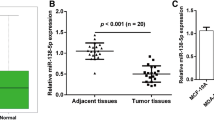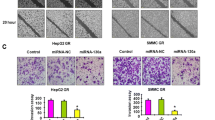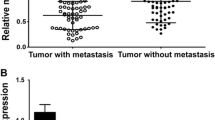Abstract
Metastasis is the leading cause of death in patients with breast cancer and aberrantly expressed microRNAs (miRNAs) are highly associated with this process. A previous study has shown that miR-335 is downregulated in breast cancer and can suppress tumor invasion and metastasis. Emerging evidences indicate that c-Met is implicated in cell scattering, migration, and invasion. However, little is known about the relationship between miR-335 expression and c-Met alteration in breast cancer. In the present study, we found that miR-335 expression was downregulated and c-Met protein expression was upregulated in two human breast cell lines. MiR-335 was found to negatively regulate c-Met protein level by directly targeting its 3′ untranslated region (UTR). Forced expression of miR-335 decreased c-Met expression at protein levels and consequently diminished hepatocyte growth factor (HGF)-induced phosphorylation of c-Met and subsequently inhibited HGF promotion of breast cancer cell migration in a c-Met-dependent manner. MiR-335 expression was increased after 5-aza-2′-deoxycytidine (5-AZA-CdR) treatment, and 5-AZA-CdR treatment resulted in the same phenotype as the effect of miR-335 overexpression. Taken together, these results demonstrate that miR-335 suppresses breast cancer cell migration by negatively regulating the HGF/c-Met pathway.





Similar content being viewed by others
References
Jemal A, Siegel R, Ward E, Hao Y, Xu J, Thun MJ. Cancer statistics, 2009. CA Cancer J Clin. 2009;59:225–49.
Weigelt B, Peterse JL, van’t Veer LJ. Breast cancer metastasis: markers and models. Nat Rev Cancer. 2005;5:591–602.
Bartel DP. MicroRNAs: genomics, biogenesis, mechanism, and function. Cell. 2004;116:281–97.
Costinean S, Zanesi N, Pekarsky Y, Tili E, Volinia S, Heerema N. Croce CM: Pre-B cell proliferation and lymphoblastic leukemia/high-grade lymphoma in E(mu)-miR155 transgenic mice. Proc Natl Acad Sci U S A. 2006;103:7024–9.
Chen CZ, Li L, Lodish HF, Bartel DP. MicroRNAs modulate hematopoietic lineage differentiation. Science. 2004;303:83–6.
Zhao Y, Samal E, Srivastava D. Serum response factor regulates a muscle specific microRNA that targets Hand2 during cardiogenesis. Nature. 2005;436:214–20.
Cimmino A, Calin GA, Fabbri M, Iorio MV, Ferracin M, Shimizu M, et al. Croce CM: miR-15 and miR-16 induce apoptosis by targeting BCL2. Proc Natl Acad Sci U S A. 2005;102:13944–9.
Esquela-Kerscher A, Slack FJ. Oncomirs—microRNAs with a role in cancer. Nat Rev Cancer. 2006;6:259–69.
Tavazoie SF, Alarcón C, Oskarsson T, Padua D, Wang Q, Bos PD, et al. Endogenous human microRNAs that suppress breast cancer metastasis. Nature. 2008;451:147–52.
Valastyan S, Reinhardt F, Benaich N, Calogrias D, Szász AM, Wang ZC, et al. A pleiotropically acting microRNA, miR-31, inhibits breast cancer metastasis. Cell. 2009;137:1032–46.
Ma L, Young J, Prabhala H, Pan E, Mestdagh P, Muth D, et al. Weinberg RA: miR-9, a MYC/MYCN-activated microRNA, regulates E-cadherin and cancer metastasis. Nat Cell Biol. 2010;12:247–71.
Ma L, Teruya-Feldstein J, Weinberg RA. Tumour invasion and metastasis initiated by microRNA-10b in breast cancer. Nature. 2007;449:682–8.
Birchmeier C, Birchmeier W, Gherardi E, Vande Woude GF. Met, metastasis, motility and more. Nat Rev Mol Cell Biol. 2003;4:915–25.
Benvenuti S, Comoglio PMJ. The MET receptor tyrosine kinase in invasion and metastasis. Cell Physiol. 2007;213:316–25.
Leelawat K, Leelawat S, Tepaksorn P, Rattanasinganchan P, Leungchaweng A, Tohtong R, et al. Involvement of c-Met/hepatocyte growth factor pathway in cholangiocarcinoma cell invasion and its therapeutic inhibition with small interfering RNA specific for c-Met. J Surg Res. 2006;136:78–84.
Ma PC, Tretiakova MS, Nallasura V, Jagadeeswaran R, Husain AN, Salgia R, et al. Downstream signalling and specific inhibition of c-MET/HGF pathway in small cell lung cancer: implications for tumour invasion. Br J Cancer. 2007;97:368–77.
Sipeki S, Bander E, Buday L, Farkas G, Bácsy E, Ways DK, et al. Phosphatidylinositol 3-kinase contributes to Erk1/Erk2 MAP kinase activation associated with hepatocyte growth factor-induced cell scattering. Cell Signal. 1999;11:885–90.
Wu ZS, Wu Q, Wang CQ, Wang XN, Huang J, Zhao JJ, et al. Zhang N: miR-340 inhibition of breast cancer cell migration and invasion through targeting of oncoprotein c-Met. Cancer. 2011;117:2842–52.
Li N, Fu H, Tie Y, Hu Z, Kong W, Wu Y, et al. miR-34a inhibits migration and invasion by down-regulation of c-Met expression in human hepatocellular carcinoma cells. Cancer Lett. 2009;275:44–53.
Tan S, Li R, Ding K, Lobie PE, Zhu T. miR-198 inhibits migration and invasion of hepatocellular carcinoma cells by targeting the HGF/c-MET pathway. FEBS Lett. 2011;585:2229–34.
Krek A et al. Combinatorial microRNA target predictions. Nat Genet. 2005;37:495–500.
Lewis BP, Burge CB, Bartel DP. Conserved seed pairing, often flanked by adenosines, indicates that thousands of human genes are microRNA targets. Cell. 2005;120:15–20.
Naldidi L, Vigna E, Narsimhan R, et al. Hepatocyte growth factor (HGF) stimulates the tyrosine kinase activity of the receptor encoded by the protooncogene c-MET. Oncogene. 1991;6:501–4.
Momparler RL. Epigenetic therapy of cancer with 5-aza-2′-deoxycytidine (decitabine). Semin Oncol. 2005;32:443–51.
Png KJ, Yoshida M, Zhang XH, et al. MicroRNA-335 inhibits tumor reinitiation and is silenced through genetic and epigenetic mechanisms in human breast cancer. Genes Dev. 2011;25:226–31.
Tuck AB, Park M, Sterns EE, Boag A, Elliott BE. Coexpression of hepatocyte growth factor and receptor (met) in human breast carcinoma. Am J Pathol. 1996;148:225–32.
Beviglia L, Matsumoto K, Lin CS, Ziober BL, Kramer RH. Expression of the c-met/HGF receptor in human breast carcinoma: correlation with tumor progression. Int J Cancer. 1997;74:301–9.
Gherardi E, Stoker M. Hepatocyte and scatter factor. Nature. 1990;346:228.
Peruzzi B, Bottaro DP. Targeting the c-Met signaling pathway in cancer. Clin Cancer Res. 2006;12:3657–60.
Garcia S, Dales JP, Charafe-Jauffret E, et al. Poor prognosis in breast carcinomas correlates with increased expression of targetable CD146 and c-Met and with proteomic basal-like phenotype. Hum Pathol. 2007;38:830–41.
Jiang WG, Grimshaw D, Lane J, et al. A hammerhead ribozyme suppresses expression of hepatocyte growth factor/scatter factor receptor c- MET and reduces migration and invasiveness of breast cancer cells. Clin Cancer Res. 2001;7:2555–62.
Cecchi F, Rabe DC, Bottaro DP. Targeting the HGF/c-MET signalling pathway in cancer. Eur J Cancer. 2010;46:1260–70.
Acknowledgments
This research is supported by the Doctoral Fund of Ministry of Education of China (No. 20125503110012).
Conflicts of interest
None
Author information
Authors and Affiliations
Corresponding author
Rights and permissions
About this article
Cite this article
Gao, Y., Zeng, F., Wu, JY. et al. MiR-335 inhibits migration of breast cancer cells through targeting oncoprotein c-Met. Tumor Biol. 36, 2875–2883 (2015). https://doi.org/10.1007/s13277-014-2917-6
Received:
Accepted:
Published:
Issue Date:
DOI: https://doi.org/10.1007/s13277-014-2917-6




